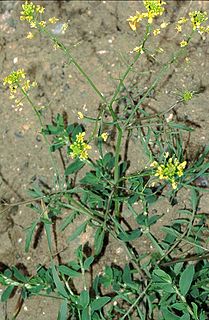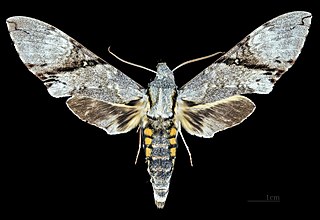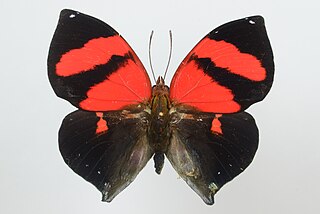
Pinus sylvestris, the Scots pine (UK), Scotch pine (US) or Baltic pine, is a species of tree in the pine family Pinaceae that is native to Eurasia. It can readily be identified by its combination of fairly short, blue-green leaves and orange-red bark.

The Salicaceae is the willow family of flowering plants. The traditional family included the willows, poplar, aspen, and cottonwoods. Genetic studies summarized by the Angiosperm Phylogeny Group (APG) have greatly expanded the circumscription of the family to contain 56 genera and about 1220 species, including the Scyphostegiaceae and many of the former Flacourtiaceae.

Angelica is a genus of about 60 species of tall biennial and perennial herbs in the family Apiaceae, native to temperate and subarctic regions of the Northern Hemisphere, reaching as far north as Iceland, Lapland, and Greenland. They grow to 1–3 m tall, with large bipinnate leaves and large compound umbels of white or greenish-white flowers. Found mainly in China, its main use was for medicine. It shows variations in fruit anatomy, leaf morphology, and subterranean structures. The genes are extremely polymorphic.

Malus sylvestris, the European crab apple, is a species of the genus Malus, native to Europe. Its scientific name means "forest apple" and the truly wild tree has thorns.

Angelica sylvestris or wild angelica is a species of flowering plant, native to Europe and central Asia. An annual or short-lived perennial growing to a maximum of 2.5 metres (8.2 ft), it has erect purplish stems and rounded umbels of minuscule white or pale pink flowers in late summer.

Rorippa sylvestris is an invasive species of plant in the United States, likely entering from Europe before 1818 from ballast water and spreading throughout North America through contaminated nursery seed stock.

Schwarziana quadripunctata is a small, stingless bee found in a stretch of the South American Amazon from Goiás, Brazil, through Paraguay, to Misiones, Argentina. This highly eusocial insect constructs earthen nests in the subterranean level of the subtropical environment, an unusual feature among other stingless bees. The species ranges in sizes from 6.0 to 7.5 millimetres and feeds on a diverse diet of flowering plants found abundantly on the forest floor, including guacatonga and the mistletoe species Struthanthus concinnus.

Casearia is a plant genus in the family Salicaceae. The genus was included in the Flacourtiaceae under the Cronquist system of angiosperm classification, and earlier in the Samydaceae. Recent research indicates that the latter group might be reinstated as a valid family.
Casearia lasiophylla is a species of flowering plant in the family Salicaceae. It is endemic to Brazil.

The Sistema Único de Saúde, better known by the acronym SUS, is Brazil's publicly funded health care system. Created in 1989, the SUS is the largest government-run public health care system in the world, by number of beneficiaries/users, land area coverage, and affiliated network/number of treatment centers. The system is entirely free of any cost at the point of service for any person, including foreigners.

Malva sylvestris is a species of the mallow genus Malva in the family of Malvaceae and is considered to be the type species for the genus. Known as common mallow to English-speaking Europeans, it acquired the common names of cheeses, high mallow and tall mallow as it migrated from its native home in Western Europe, North Africa and Asia through the English-speaking world.

Brazil has great forests. Minas Gerais, Brazil's central state, larger domain is the tropical forest. Within it there are many types of plants. Separated by families this is a list of these plants:

Traditional Brazilian medicine includes many native South American elements, and imported African ones. It is predominantly used in areas where indigenous groups and African descendants reside, like in the northeast coast, nearly all interior regions including Amazon regions, savannahs, rainforest, foothills, and Pantanal. According to Romulo R. N. Alves, "although Brazil's health system is public...use of traditional remedies and rituals provide an economical way of healing for much of the populace, but that also does not mean that wealthy Brazilians don't seek it out as well. Traditional medicine is a deep part of Brazilian heritage."

Salvia is the largest genus of plants in the sage family Lamiaceae, with nearly 1000 species of shrubs, herbaceous perennials, and annuals. Within the Lamiaceae, Salvia is part of the tribe Mentheae within the subfamily Nepetoideae. One of several genera commonly referred to as sage, it includes two widely used herbs, Salvia officinalis and Salvia rosmarinus.

Manduca lefeburii is a moth of the family Sphingidae.

Siderone galanthis, the scarlet leafwing or red-striped leafwing, is a species of butterfly of the family Nymphalidae. It is found from Mexico to southern Brazil. The habitat consists deciduous and evergreen forests at altitudes up to 900 meters.

Elaeocarpus sylvestris, the woodland elaeocarpus, is a tree species in the genus Elaeocarpus.

Tulipa sylvestris, the wild tulip or woodland tulip, is a Eurasian and North African species of wild tulip, a plant in the lily family. Its native range extends from Portugal and Morocco to western China, covering most of the Mediterranean and Black Sea Basins, and Central Asia. The species is also cultivated as an ornamental and naturalized in central and northern Europe as well as a few scattered locations in North America. It was first recorded as being naturalised in Britain in the late 17th century.
Casearia bartlettii is a species of flowering plant in the family Salicaceae found in Mesoamerica (Belize-Guatemala).

















